|
The first of non-folding Kodak Retinas, the Kodak Retina IIS, was introduced in 1959. Initially sold alongside the folding Retinas, they were soon to replace them altogether. Most non-folding Kodak Retinas were rangefinders and all had lightmeters. Generally they came with fixed lenses, but one model, the IIIS, had an interchangeable mount and a wide range of lenses of different focal lengths.
In some respects the non-folding models were a step down from the folding Retinas. For example, nearly all came with f/2.8 Xenar lenses instead of the optically superior Xenon or Heligon lenses on the folders. Only the IIIS had an optional Xenon f/1.9 interchangeable lens. In the end, the non-folders were less successful than the folders had been; the whole production of non-folding Retinas (ca. 350,000) barely exceeded that of Kodak Retina IIIc and C series alone. They were superseded by the Retina Reflex range.
Kodak Retina IIS
This was the first non-folding Retina rangefinder and followed soon after the introduction of the first non-folding Retinette (type 022). It had a coupled lightmeter - by turning a small knob at the bottom of the shutter, one would change the exposure as well as move a marker needle in the lightmeter. Once the marker was aligned with the lightmeter needle, the exposure was correctly set.
Another new feature were the little red depth of field indicators on the lens, which would move whilst setting the aperture. These were soon after introduced on the Retinette II and IIB also.
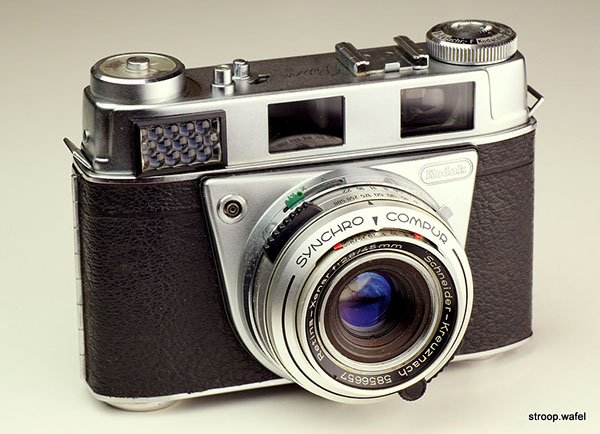
A Retina IIS, the first non-folding Retina and the first to feature a coupled lightmeter. It came with a Schneider Retina-Xenar 45mm f/2.8 lens.
Kodak Retina IIIS
The Retina IIIS is the only non-folding Retina with some sort of cult status due to its interchangeable lens mount. Otherwise it was quite similar to the IIS although it had a slightly wider body.
The lens mount was called the Deckel bayonet or also the Compur Quick Change Mount. Several other cameras used this mount, for example the Balda Baldamatic III, the Iloca Electric and the Voigtlander Vitessa, but most importantly, the Retina Reflex series (with exception of the first model). Since the whole lens was changed, not just the front part like for the Retina c mount, one could in principle use any lens with the same mount. However, the different camera brands had slightly different flange cut-offs or positions of aperture levers, so true interchangeability was not achieved.
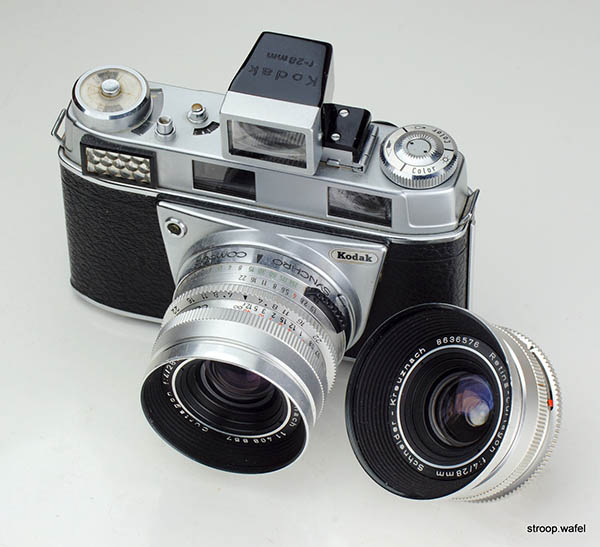
A Retina IIIS with 28mm f/4 Retina Curtagon, one of the widest lenses available at that time. The Retina SIII did not have a viewfinder frame for the 28mm lens, so a separate 28mm viewfinder was also available. There were two different versions of the Curtagon, one with a closest focus of 0.9m (the one on the right in the photo) and a later one which could focus down to 0.6m, here mounted on the camera.
A wide range of focal lengths was available for the Retina IIIS, undoubtedly helped by the popularity of the later Reflex Retinas. These included 35mm f/2.8, 50mm f/2.8 and f/1.9, 85mm f/4 and 135mm f/4 lenses, for which the frame lines visible in the viewfinder were automatically adjusted to the correct focal length, as well as additional 28mm f/4, 30mm f/2.8 and 200mm f/4.8 lenses which needed separate viewfinders (I am not sure Kodak actually sold these). The latter had no rangefinder cam so would need an external rangefinder or one could perhaps measure the distance first before changing lenses. Once the Retina IIIS was taken out of production, the S mount lenses no longer had rangefinder cams, which made them inconvenient to use on the IIIS. One could recognise these as they no longer had 'Retina' in front of their name. As the frame lines in the IIIS viewfinder are coupled to the rangefinder cam, I assume these lenses would also not show different frame lines, but I have no appropriate lens to test that. Most of these new lenses were closer focusing, e.g., the standard lens focussed down to 0.9m to 0.6m. The 85 mm lens was updated to 90mm. Most lenses were available from Schneider as well as Rodenstock, the latter were far less common and are nowadays particularly expensive.
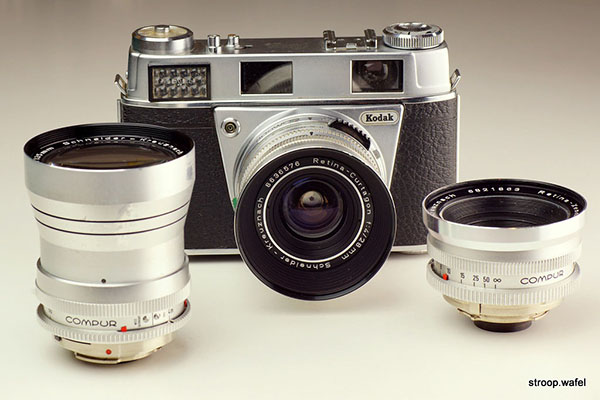
A Retina IIIS outfit with additional 135mm f/4 Tele-Xenar and 50mm f/1.9 Xenon lenses.
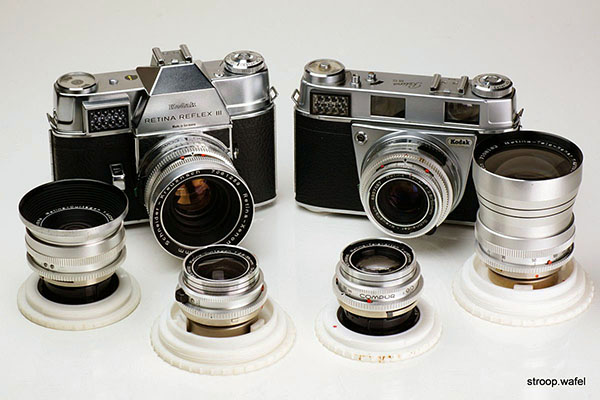
A Retina IIIS and Reflex III with a complete line up of available Schneider lenses that could be used on both cameras, i.e., with rangefinder cams. From left to right a Retina-Curtagon 28mm f/4, a Retina-Curtagon 35mm f/2.8, a Retina-Tele-Arton 85mm f/4 and Retina Tele-Xenar 135mm f/4.
Kodak Retina Automatic II
The Retina Automatic range was introduced in 1960 with the Automatic II. I did not feature a rangefinder but had a bright-line viewfinder instead. All Automatics featured automatic exposure, but in different ways. On the Automatic 2 (and 3), the camera would select an aperture based on the selected shutter speed, which could be viewed in the lightmeter window on top of the camera. One could, however, also select an aperture setting manually. As can be seen on the photos, the cameras also featured a cosmetic makeover of the rangefinder / lightmeter area of the top housing, not unlike the Agfa Silette range of that time. In addition, the shutter release moved to the front of the camera, again something that was seen on other cameras from that time.
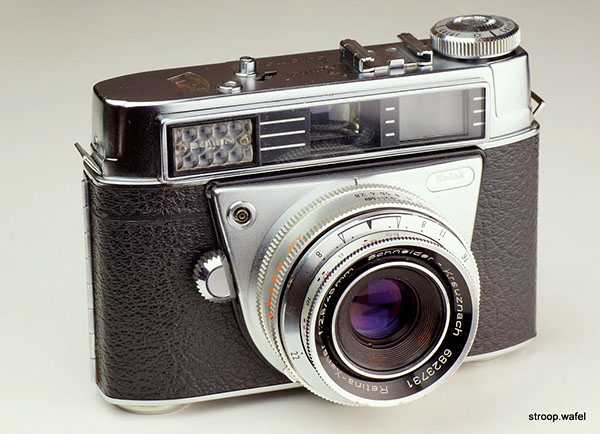
An Automatic II with the newly styled top housing.
Kodak Retina Automatic I
The Automatic I was the cheaper little brother on the Automatic II and in fact it was more comparable to the Retinettes, as it features a Prontormat shutter and a Reomar lens. The exposure system was identical to that of the Retinette IIA: there were no speed or aperture markings on the shutter, one would simply turn the exposure ring until the lightmeter needle in the viewfinder would match the marker. Presumably the shutter speed was fixed.
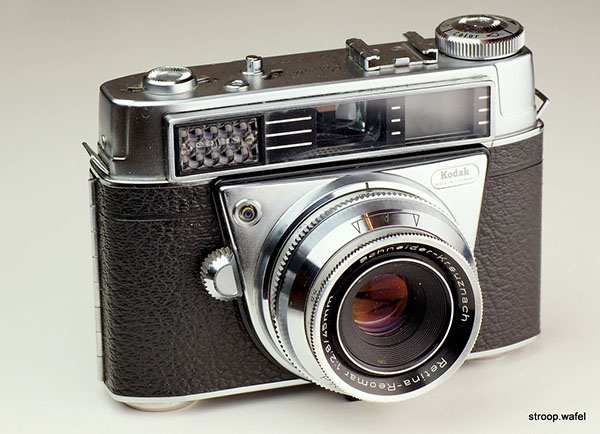
An Automatic I, with similar specifications as the Retinette IIA.
Kodak Retina Automatic III
The Automatic III is the rangefinder version of the Automatic II. Therefore, the eyepiece on the back of was on the far left, whereas on the Automatic II it was in the middle. It also featured a larger lightmeter cell for enhanced accuracy at low light levels. This is in fact a nice camera to use with a convenient little tab on lens to change focus with one finder while holding the camera steady with both hands. This tab was missing on the viewfinder cameras as one would adjust the focus first before framing the shot. However, none of the later rangefinder models have it.
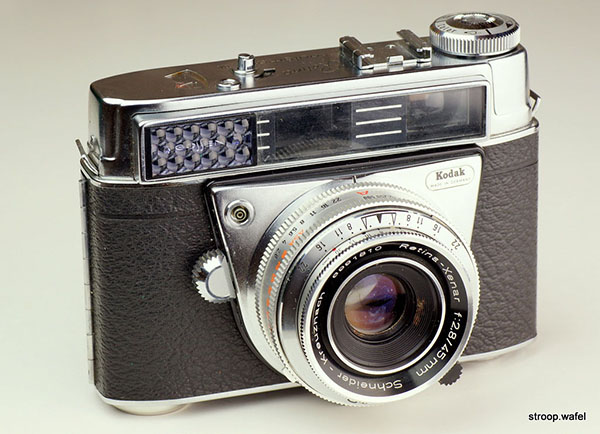
An Automatic III, note the convenient little focus tab. This was the most sold non-folding Retina.
Kodak Retina IBS
The Retina IBS was introduced in 1962 and appears to be the rarest of the lot. It featured an updated top housing, the rewind knob and accessory shoe were made flush with the top of the camera. It did not have a rangefinder, but had a bright-line viewfinder instead. The light meter needle was projected in the viewfinder, a feature first introduced on the Retinetta IIA. It did not, however, feature the light-value exposure system; instead one would set shutter speed and aperture independently.
I have been pondering about the name IBS, perhaps it was a modification of IIS, where the IB part indicated it was a viewfinder camera, analogous to the IIc and IB folding cameras.
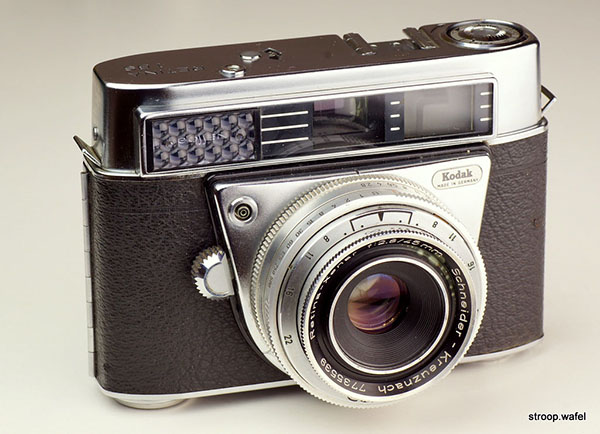
A Retina IBS with newly styled top housing.
Kodak Retina IF
The Retina IF and IIF featured an integrated flash in its simplest form: a small flip-up reflector and a flash bulb socket. Due to the space taken up by the flash unit on the top housing, the frame counter moved to the base of the camera for the first time in the long history of Retinas. Also on the base of the camera was a battery compartment, necessary for firing the flash only. The Retina IF had no rangefinder and the shutter (a Prontor 500 LK) and focus scale were the same as on the last Retinette IB model. Exposure setting was similar as on the Retina IBS. Curiously, no flash specific settings are indicated on the camera.
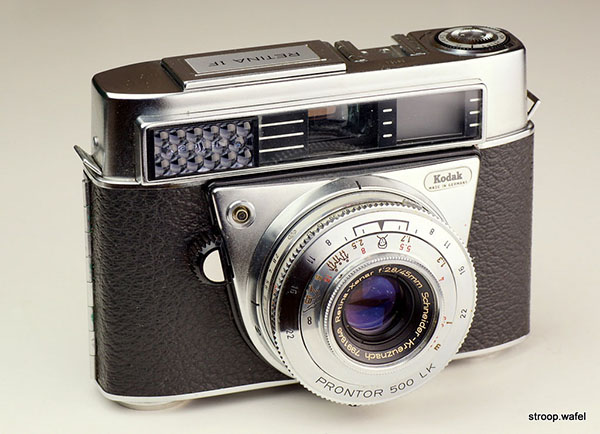
A Retina IF with built-in flash unit.
Kodak Retina IIF
The Retina IIF was the last of the non-folding Retinas, apart from two hideous little plastic cameras called the S1 and S2 that did not really deserve the Retina name. After this camera only the Reflex IV carried on the Retina name. The main difference with the IF was that the IIF did have a rangefinder and a Compur shutter. The exposure system was identical.
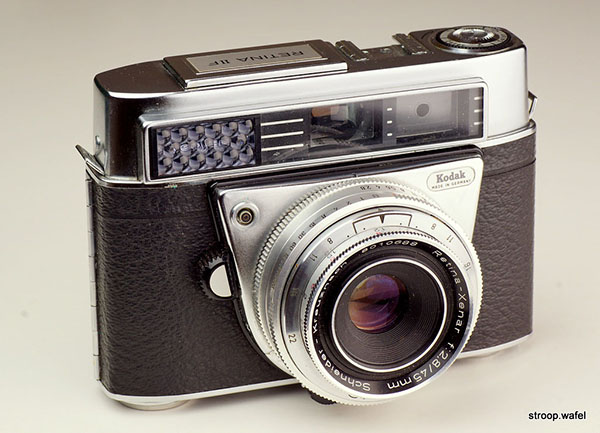
A Retina IIF, the last of non-folding Retinas.
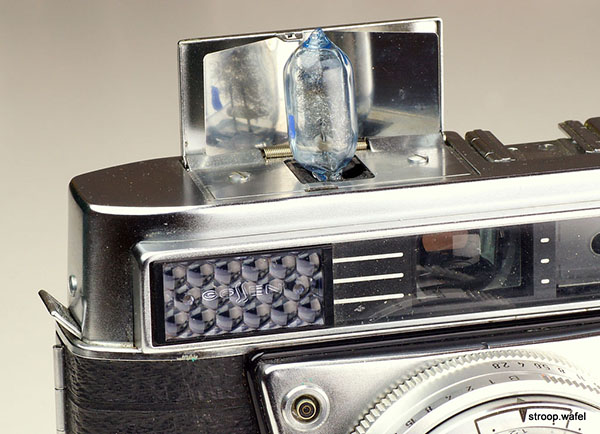
A Retina IIF with 'blue dot' AG3B flash bulb inserted.
Kodak Instamatic 500
Not a Retina, but the Kodak Instamatic 500 felt out of place on my 'non-Retina' page which only has cameras from Kodak USA so far. The camera even had a 'Type' number like the Retinas and the Schneider-Kreuznach Xenar lens clinched it!
The Kodak Instamatic range was a series of very successful cameras for 126 film cassettes, which were popular in the 1960s. They ranged from the simplest point and shoot cameras to advanced models, such as the Instamatic Reflex on the Retina Reflex page. The Instamatic 500 was the top of the range model of the pocket-size models. Apart from the Xenar lens already mentioned, it sported a large selenium cell coupled lightmeter and a front-focussing lens with zone focusing as well as distance markers. The shutter had a decent range of shutter speeds varying from 1/30 to 1/500s. The exposure settings were fully manual with the lightmeter needle conveniently shown in the viewfinder. Rather strangely (and not mentioned in the manual!), the lens was partially retractable, which saves about 6mm in length. I wouldn't risk spoiling photos by forgetting to extend the lens for the sake of a minimal increase in portability! The camera also came with an impressive case which could be split into a heavy duty cradle.
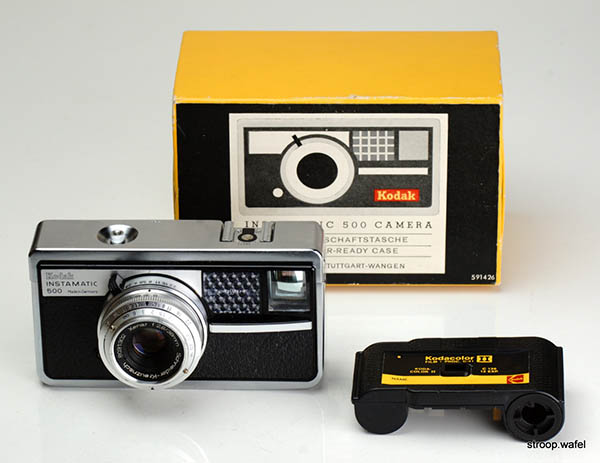
A Kodak Instamatic 500 with its original box and an instamatic film cassette.
Kodak Retina S2
Not a Retina to be proud of, the Kodak Retina S2, and I have hesitated a long time before getting one. A very cheap offer and a somewhat compulsive desire to get complete collections did it in the end, so here it is. The Retina S1 and S2 were the last two models of the Retina range, introduced 30 years after the first one, in 1966. They were typical examples of the state of the German photographic industry at the time: costs needed to be cut and the focus was on small margins and large numbers. Other German manufactures like Agfa and Balda went a similar route, many others had perished before.
The Retina S2 was a simple viewfinder camera with a selenium lightmeter, at a time when most cameras had moved to CdS cells. The lens was a Reomar, the stallwarth lens of the Retinette line. The camera had a mount for the then popular flash cubes. It was a fully manual camera, setting the exposure was aided by the needle of the coupled lightmeter being visible in the viewfinder. The camera had a battery compartment, but the battery was only needed for flash photography. The Retina S1 was nearly identical to the S2 but lacked the lightmeter. All in all a rather sad end to one of the most iconic lines of cameras that saw the light last century.
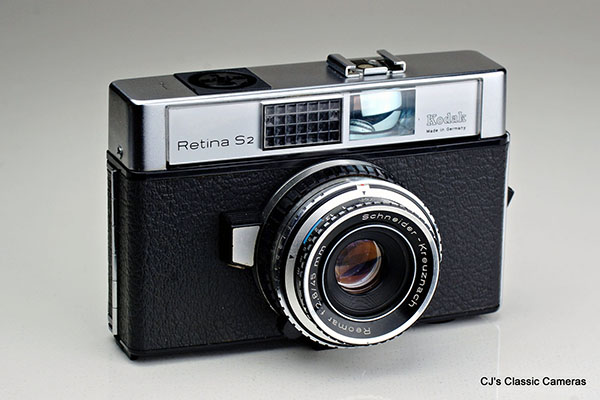
A Kodak Retina S2, officially the last of Retinas, but see the Instamatic Reflex, a Retina in all but its name and a more fitting end to one of the greatest lines of cameras produced last century.
|

